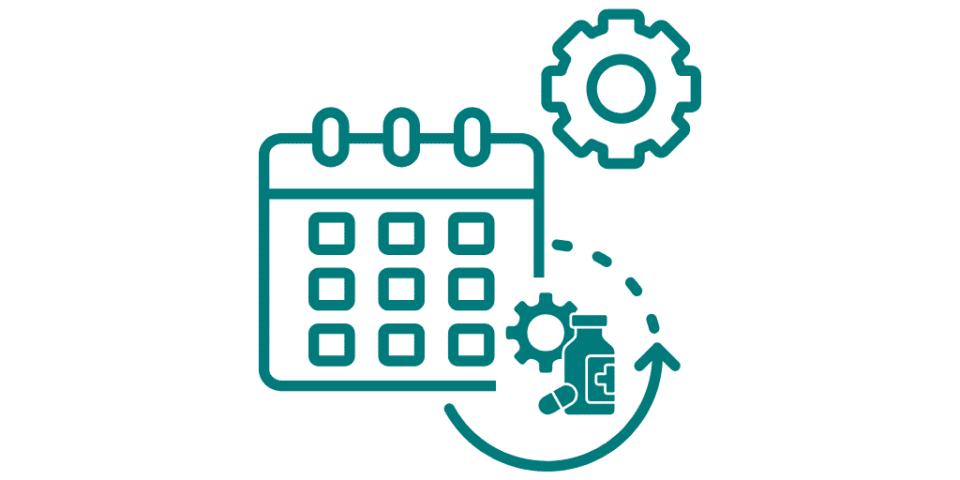Mastering the Art of Controlled Release: A Journey Through Drug Formulation Complexities.
An Interview with Kyriakos Michailaros
Could you introduce yourself and your expertise in drug development and manufacturing?
Following on from my university studies, my career has centered around the development and production of pharmaceuticals.
Upon earning my degree in chemical engineering, I began my professional journey in clinical trial manufacturing at a prominent pharmaceutical corporation.
Subsequently, I worked for several mid- and large-sized pharmaceutical companies, focusing on the development of drug products, formulations, manufacturing processes, troubleshooting, commercial support, and the introduction of new products. This is also the type of work that I have been doing with DSI for the last 14 years.
Can you highlight the importance of controlled-release drug formulations?
Controlled-release technology plays an essential role in drug delivery, particularly for diseases where patients prefer not to take medications multiple times a day. By incorporating controlled release technologies into drug products, we can alleviate the pill burden on patients.
This approach offers numerous advantages in specific formulations, including minimizing dosing frequency for patients and ensuring a more steady medication concentration in their system over time.
Can you outline specific challenges in developing controlled-release drug formulations and how your expertise addresses these complexities?
When formulating for controlled release, there are certain constraints due to the chemistries of different active ingredients and their interactions with various types of controlled-release modifying excipients and other components in the drug product, which influence how the drug is released in the body.
Selecting appropriate excipients to regulate drug release is crucial, necessitating thorough screening work. However, different drugs and control-release polymers exhibit variations in pH, ionic characteristics, partition coefficients, and physical properties. Matching the suitable excipient with the drug presents a challenge when trying to achieve the desired release profile.
Another significant challenge is managing intellectual property claims related to drug release. Some companies may hold patents on specific release mechanisms, making it crucial for us to avoid infringing on these patents when developing competitive drugs.
While this is a consideration that only tends to arise occasionally, the primary challenge is still ensuring that the drug formulation and excipients are carefully matched with the active ingredient to achieve the desired overall release profile.
What is DSI’s strategy for ensuring efficient scale-up and process transfer for controlled-release drug products?
When collaborating with a client, we prioritize understanding the potential trajectory of the drug product project upon successful completion. Cost efficiency is a paramount concern for our clients, and we strive to identify the most efficient pathways to achieve their goals.
By gaining clarity on the desired end result, we can streamline experimental work and tailor the design of our developmental efforts to acquire the necessary information for an FDA-approved dosage form.
However, it all starts with understanding the end goal and avoiding unnecessary development work or the pursuit of formulation avenues requiring extensive iteration and refinement to achieve the desired outcomes.
Leveraging our extensive experience honed through the development of numerous products under time constraints, we excel in streamlining experiments. Our approach ensures that we conduct only essential tasks tailored to each specific product, thereby maintaining adherence to schedules as efficiently as possible.
How does DSI’s early involvement in drug development save time and money and what methods are used in planning and executing controlled release formulations?
Initiating early discussions with clients regarding the desired performance of the final dosage form to meet patient needs allows DSI to adhere to a developmental program focused solely on gathering the necessary information and maintaining product progress.
What strategies does DSI employ to overcome challenges related to varied release times and bioavailability improvement in controlled release formulations?
This relates back to the drug formulation challenges previously discussed. Different active ingredients exhibit compatibility with different excipients and the desired release profile may vary depending on the medical indication, ranging from immediate to prolonged release duration of four, six, eight, 20, or 24 hours.
Once the target release profile has been established, our extensive expertise then comes into play, formulating products that are released over specific time periods.
We begin by screening excipients that show promise in conjunction with the active ingredient under consideration. We then meticulously fine-tune the proportions of each component to achieve the precise desired profile. This iterative process allows us to craft formulations that meet the exacting requirements of the intended application.
Can you provide some examples of non-sterile drug product formulation and how DSI tailors its approach to different types, such as immediate, controlled, and extended-release?
In the realm of oral products, most fall under the non-sterile category. These encompass tablets, capsules, oral liquids, and sprinkle formulations. The strategies for developing a drug product heavily hinge on its intended purpose, the targeted disease it aims to treat, and the specific patient population it serves.
For instance, pediatric populations have difficulty swallowing tablets or capsules. As a result, our formulation strategies for these types of products prioritize formulations that minimize swallowing issues. Oral liquids and occasionally sprinkle formulations may present taste-related challenges that necessitate careful consideration during formulation development.
In the case of controlled or extended-release formulations, several well-understood technologies exist, such as matrix formulations or osmotic pump formulations. These innovations can extend the release time of a tablet by up to 24 hours in certain scenarios.
However, the key lies in comprehending the patient population, their specific ailment, and the frequency of drug intake. By taking these factors into account, we can tailor a drug product to ensure optimal and efficient release.
What are some considerations and challenges unique to sterile development, and how does DSI address them?
A major concern in sterile development revolves around upholding sterility and cleanliness within the processing environment until the drug product is released. DSI boasts a team of professionals with extensive expertise in parenteral manufacturing, namely sterile manufacturing.
Having navigated numerous product development cycles, launches, and audits, these experts possess a deep understanding of the critical elements that demand prioritization within sterile manufacturing processes.
How does DSI support drug product manufacturing?
Our approach is primarily driven by the requirements of our clients. We provide tailored support that is aligned with their specific needs. Whether it is providing full-time technical expertise to actively participate in drug development meetings, spearheading drug development initiatives, outlining experiment plans, or assisting in vendor selection and management, we offer comprehensive services.
Additionally, we conduct on-site visits to vendor facilities to assess protocols and occasionally draft protocols for both our clients and their vendors to adhere to.
We actively participate in critical batch manufacturing by traveling to ensure our presence. Additionally, we remain accessible via phone or email to address any inquiries promptly.
Our engagement typically entails semi-regular, often weekly meetings with clients to address ongoing drug development concerns. We take charge of writing and reviewing protocols for all experimental development tasks necessary to guide the product through various phases of clinical trials.
We have all the chemistry and manufacturing controls in place to put the package together for our clients.
How does DSI offer support for drug product regulatory affairs?
We achieve this by maintaining active involvement throughout the entire drug product development process. Our role is to ensure that each step aligns with regulations and guidance provided by key regulatory bodies such as the FDA, EMEA, and ICH (International Conference for Harmonization).
Through ongoing engagement with our clients, we ensure compliance with the anticipated regulatory CMC (Chemistry, Manufacturing, and Controls) requirements for their drug products. We also have regulatory experts who specialize in communicating with the agency and drafting correspondence documents for end-of-phase two, end-of-phase three, and pre-approval meetings with the agency.
DSI has done it all for clients, from being present for development activities to helping answer questions and assisting them with drafting briefing books, submissions, NDAs, INDs, IMPDs, and all types of regulatory documents and communications.
In addition to our analytical and manufacturing experts, we also have a dedicated team of regulatory affairs professionals on hand to help.
About Kyriakos Michailaros
Mr. Michailaros has over 21 years of experience in developing and manufacturing drug products, both in oral and solid forms. He specializes in difficult technical formulation and manufacturing challenges and products with unique requirements, including controlled release, zero-order release, abuse deterrence, pediatric formulations, oral disintegration.
He has worked on a variety of products with unique requirements, like controlled release, zero-order release, abuse deterrence, pediatric formulations, and oral disintegration.
During his career, Mr. Michailaros has successfully developed and improved various products, including controlled-release tablets, abuse-deterred capsules, pediatric formulations, solid and liquid-filled capsules, suspensions, inhaled products, and transdermal.
Before joining DSI, Mr. Michailaros was a senior engineer in validation and commercial technical services at Teva Pharmaceuticals and Johnson & Johnson. He has served DSI clients for over ten years. He earned a chemical engineering degree from Lehigh University and a mini-MBA in Management Essentials from Rutgers University.





